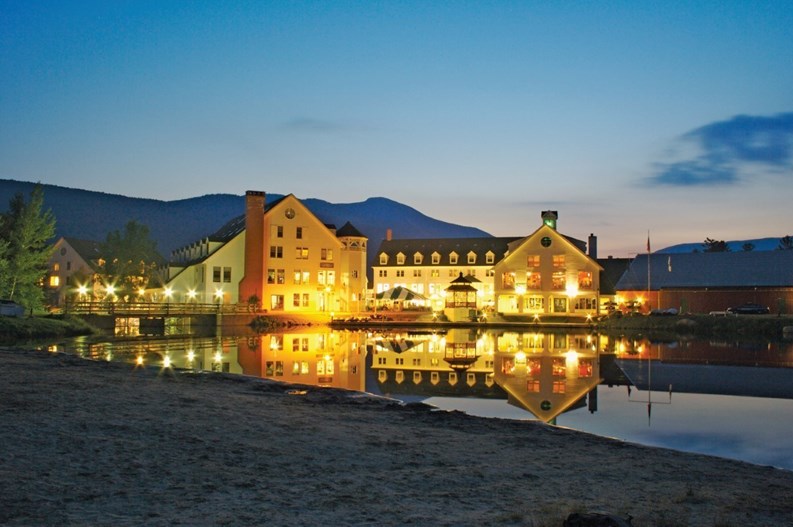One of New England’s more unique resort communities, Waterville Valley, New Hampshire, beckons like an oasis from the heart of the White Mountain National Forest. Two hours from Boston and served by one main road – Route 49 –the village only claims about 300 year-round residents. However, from all accounts, the community is bustling and open for business all year through.
Before and After
Settled in the 1760s, incorporated as Waterville in 1829, Waterville Valley underwent major changes in the mid-1960s – and not in name only – when the Mount Tecumseh Ski Area started. Previously, the community had been a summer destination, with guests vacationing at the Waterville Inn or one of twenty private cottages. Winter visitors didn’t start making their way there until after the Second World War. In earlier incarnations, Waterville had been a farming, and then a logging, community.
In 1965, the Waterville Company, Inc., formed and began to develop the multifaceted resort community best known for recreational skiing that exists today. According to Kate Wheeler, associate broker at Waterville Valley Realty (WVR), the Waterville Company’s real estate arm, the entire village only comprises about 500 acres, about 91 percent of which has been developed. Wheeler admits that there is “not a lot of room to grow,” but waxes eloquent on how the valley, surrounded as it is by 44,000 acres of woods, is like“an island in the middle of the forest. It’s really unique geographically. I’ve never been to another place like it.”
In 2010, a change of ownership occurred when The Sununu family (New Hampshire’s most prominent political family) and a group of local investors purchased the Waterville Valley assets from Booth Creek Ski Holdings Ltd., a California-based company, according to Jan Stearns, WVR’s marketing director.
The assets have not been controlled locally for at least fifteen years, but with the new ownership, Stearns asserts, “the money that is made in Waterville Valley (and these facilities do make money) will stay in Waterville Valley.” Chris Sununu and resort founder Tom Corcoran have been discussing ways to grow the resort to fully realize its potential. Stearns quotes Sununu as saying, “The future of Waterville Valley will rest largely upon our abilityto create a more full vacation experience for families 365 days a year, for ages one to one hundred.”
Stearns explains, “The bottom line isthat the resort was not in dire straits prior to the sale by Booth Creek. But its vacation business was stagnating, as the previous owners did not reinvest into the resort’s facilities. Despite that, real estate buyers continued to show their faith and confidence in the resort by continuing to buy... ”
Settling In
The majority of properties in Waterville Valley are condominiums, ranging from one- to five-bedroom. There are twenty-six different complexes in the village. Two are hotel-style and twenty-three are residential, while the remaining one offers “quarter-share” ownership: one property can have up to four owners, each of whom owns it for up to thirteen weeks a year. The median range for a condo unit is between $200,000 and $300,000.
WVR does not offer short-term rentals, but Wheeler notes the winter rental season is a particularly good source of buyers. Stearns says that in contrast to the overwhelming number of condos, there are 147 single-family homes. Still, within the last seven years, two different single-family home developments were released. The most recent, Moose Run, has all but sold out, Stearns says, “making it perhaps the most successful single-family home development in the state.” She adds that “the homes at Moose Run show a distinct trend towards green building,” which she maintains is consistent with the valley’s commitment to the surrounding environment. Certain tax incentives are available to homeowners whofit their homes in keeping with this commitment.
Stepping Out
Naturally, such a unique location with such unique housing options has a unique lifestyle. The local Recreation Department is an integral part of the running of the community, and is active year-round so that everyone else can be. During the spring and all the way through the autumn, hiking, fishing, biking, running, golf, tennis, skating, picnics and carnivals are options for both the year-round resident and the visitor. In the winter, Mount Tecumseh makes skiing and snowboarding naturalpastimes. Snowshoeing, hockey, ice-skating and cross-country skiing are also popular activities.
The less athletically inclined, or those with a broader diversity of interests, can find plenty to do as well. The village boasts boutiques and shops, from bookshops to gift shops to a candy store. Eclectic restaurants from the Coffee Emporium to Diamond’s Edge North are ready and waiting for one’s dining pleasure. Visitors can relax in the ski lodges or at the spa, and drop by the Margret and H.A. Rey Center and Curious George Cottage for children’s story time and adult discussions. One Waterville Valley tourist website boasts of the village, “It’s also home to a thriving arts community –including New Hampshire’s only outdoor Shakespeare repertory theatre, galleries, outdoor concerts, classical music camp and concerts, lectures, festivals and more.”
The Recreation Department maintains a babysitter list for the convenience of visitors, although they do not take responsibility for the quality of the babysitters on the list. During the warmer months, outdoor non-denominational Christian church services are periodically offered. The Recreation Department ensures that special events are held throughout the year as well, including contests, package deals (like “Wicked Long Ski Weekends” and “Kids Ski FREE Weekends”) and holiday happenings.
“Little Red School”
The year-round population of 300 residents does include children, who attend the “Little Red School,” from kindergarten to eighth grade. The number of students at the school ranges from 25-45. High-schoolers attend Plymouth Regional High School in Plymouth, New Hampshire, or Holderness School, a preparatory school south of Plymouth. Plymouth also houses a state college and is the primarytrading center for Waterville Valley. Hospital services there are affiliated with the Dartmouth-Hitchcock Medical Center about an hour away.
In spite of the small number of year-round residents, the village can have between 4,000 and 6,000 people in it at any given time. Wheeler says that Waterville Valley is a “very family-orientedplace... families with smaller children especially love it because of its quaint feel.” With so much to do in such a homey atmosphere, it’s no wonder people visit the oasis all year long... and many decide to stay. As Stearns says, “The advantage of owning real estate assets like Waterville Valley real estate is that you can stay in it. Walk on it. Enjoy it with your family and friends. Purchasing at Waterville Valley allows you to invest in the things that you believe in and that reflect your values.”
Jennifer Grosser is a freelance writer and a frequent contributor to New England Condominium magazine.







Leave a Comment